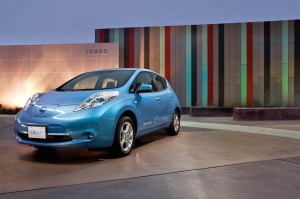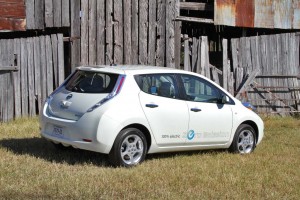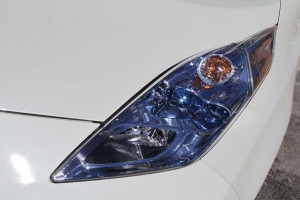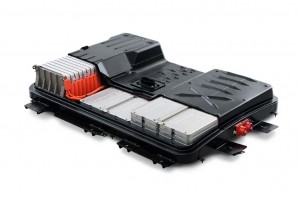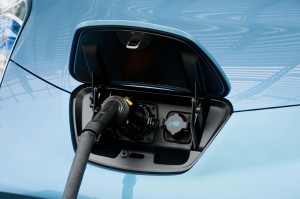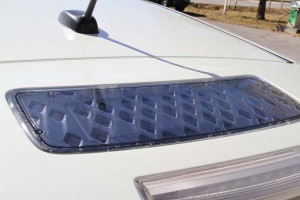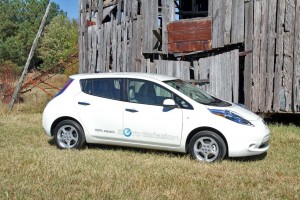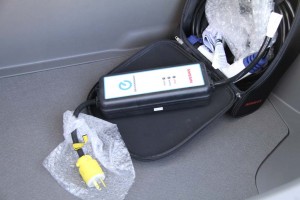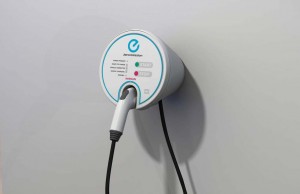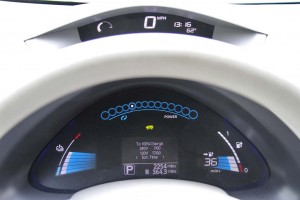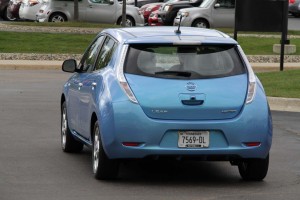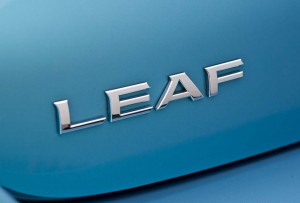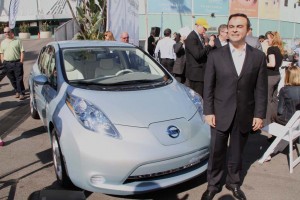Rolling down the entrance ramp and spotting an open space between the trucks clogging up I-65, I stomp on the accelerator of my 2011 Nissan Leaf, watching it race from 60 to 70, 75 to 80, finally peaking just short of 95.
All right, I probably didn’t need to move quite that fast but I admit I was curious to see just how far I could push the new Leaf, after finally getting a chance to drive the production version, recently, down near the maker’s suburban Nashville U.S. headquarters.
The 2011 battery-electric vehicle, or BEV, is a far cry from the cramped and sluggish battery cars I’ve driven over the years. It’s surprisingly roomy, well outfitted and, most surprisingly, quite a bit of fun to drive. But as I headed out for a couple hours of motoring through the fall-colored Tennessee countryside, the big question was whether the new Nissan offering was ready for prime time.
Or, perhaps the alternative way of asking the question is whether American motorists are ready for a battery car that can meet their typical daily needs but not necessarily their perceptions.
The launch of the 2011 Nissan Leaf — along with Chevrolet’s new Volt plug-in hybrid – marks a major transition in the automotive world. Industry forecasters predict there’ll be as many as three dozen battery cars of one form or another on the road by mid-decade but these two offerings will be blazing the path and how they fare with consumers could determine the long-term acceptance of electric propulsion.
The technology has actually been around for more than a century. Indeed, at the first New York Auto Show, there were more battery cars than vehicles running on gasoline. But then as now, range was the big issue, one even Henry Ford hoped to solve with the help of his good friend Thomas Edison.
The limited range issue sank California’s plan to mandate battery cars in the 1990s, but industry planners are betting that while nowhere near perfect today’s latest lithium-ion technology can boost performance enough to overcome so-called range anxiety.
In the case of the 2011 Nissan Leaf there are 24 kilowatt-hours of prismatic LIon batteries onboard. That term refers to the way the cells are packaged. Unlike the flashlight-style cylindrical batteries used in most current hybrids – and Tesla Motors’ 2-seat Roadster – Nissan has opted for a flat pack design that makes it easier to package the batteries into the floor of the little hatchback.
That has a number of advantages. For one thing, it lowers the center of gravity, which improves the Leaf’s on-road handling.
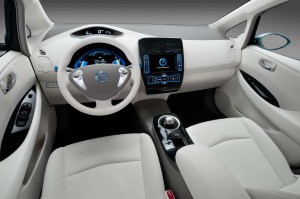
Though rated a compact according to is exterior footprint, the tall Leaf design yields a midsize interior.
It also reduces the impact on interior and cargo space. Using a unique platform only loosely derived from the Nissan Versa, and nearly half a foot longer than that minicar, the 2011 Leaf may fall into the compact category but it delivers a surprisingly spacious midsize interior.
As I noted in an earlier review of a pre-production model, the cabin is well executed with a distinctly high-tech feel, with several different digital displays, including a small navigation screen atop the center stack, and others visible both between and looking over the steering wheel.
Beyond the basic navigational duties, the bigger screen can be configured to show how far you can drive without recharging – and to help you locate the nearest public charging stations. The various LCD displays take on numerous other duties, including letting you know when you’re either hot-footing it or maximizing your energy efficiency. Indeed, as you learn to avoid jarring lead-foot starts, a little digital pine tree will appear to grow alongside the speedometer.
I have to admit to falling into the aggressive driving category, but the various displays seem to encourage even someone like me to ease off a bit – as does the idea of getting stranded somewhere desperately looking for a place to plug in.
Since comparisons are inevitable, Leaf is not quite as lavishly executed as the Chevy Volt, but that should be no surprise considering it also costs nearly $9,000 less. (And we’ll get back to pricing shortly.)
(Click Here for TheDetroitBureau review of the Chevrolet Volt.)
One thing Nissan deserves credit for is the effort it has put in to reduce noise levels while driving the 2011 Leaf. That may surprise some folks, as battery cars are known to be far quieter than conventional gas-powered models. But the lack of a noisy internal combustion engine unmasks what engineers like to call the stumps-in-the-swamp, all the other sounds you normal don’t hear when your I4 or V6 is whirling away. That required steps to deaden all sorts of sounds, from tire noise to the pulsing of the windshield wipers.
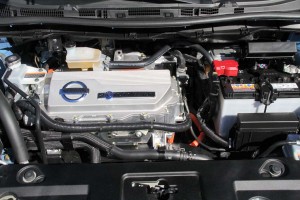
Batteries are mounted in the underbody, with the drivetrain where you'd expect it, up front under the hood.
And that often mandated some interesting innovations. Like the Toyota Prius, Leaf has a strikingly distinct appearance – even more than Volt, you won’t confuse the new Nissan with any other mainstream automobile . Some of that was done for marketing purposes, of course, but aerodynamics played a critical role. Leaf has one of the lowest coefficients of drag on the market, and by reducing wind resistance designers squeezed out perhaps 20 more miles of range.
But the unusual, bulging headlights had an additional purpose. They divert airflow away from the vehicle, and that, in turn, reduces the wind noise normally created by the exterior mirrors.
While not quite Lexus quiet, the Nissan Leaf is a clear benchmark in its size and price class.
“Remarkably unremarkable” was the mantra for Nissan engineers, suggests Mark Perry, the maker’s electric vehicle planning chief. Yes, there are the compromises on range and charging but essentially, the maker concluded, Leaf has to be as good or better in most categories as anything else on the road.
One place was in terms of urban acceleration. What many folks don’t seem to realize is that electric propulsion actually has some distinct advantages when it comes to performance. You get maximum torque the moment the motor starts turning. And the numbers quoted for electric power tend to be understated when compared what to what you see with an IC engine.
Leaf’s motor is rated at 80 kilowatts of power, or 107 horsepower. But it also yields 280 Newton-meters of torque, which translates into an aggressive 207 lb-ft. While there’s no official 0 to 60 number, Nissan CEO Carlos Ghosn has suggested it’s in the range of “less than 10 seconds,” while Perry contends the 0 to 35 mph launch is more in line with a peppy V6, ala an Altima.
As with other battery cars, acceleration will then then taper off. Though acceleration is sluggish once you get up to highway speeds, we had no problem, as earlier suggested, merging into traffic, and actually nudged a wee bit beyond the stated top speed of 90 mph.
Of course, as we pushed the little battery car to its limits we could see the impact on those digital displays, our Nissan Leaf’s range gauge ticking down nearly as quickly as the seconds on a countdown clock.
On average, Nissan forecasts the Leaf will get about 100 miles per charge – which takes about 15 hours on 110 volts and somewhere between 7 and 8 using a high-speed 220 volt charger. In reality, notes Perry, range can run anywhere from 70 miles up to 140, as one of our colleagues experienced during the Nashville preview.
Why the difference? It depends, for one thing, on when you drive, and then on how you drive. Weather is as much a factor as driving behavior, electric heat potentially cutting your mileage by nearly half if you’ve got it blasting on full on a cold Michigan winter morning.
The optimum driving situation is one in which you’re chugging along at 30 to 40 mph, occasionally braking or coasting to regain lost energy through regenerative braking, and with the climate control off. The worst situation is with climate control on and the car creeping along in slow and heavy traffic.
Nissan has a built-in Eco Mode. Switch to it and you’ll immediately see the range gauge jump by about 10%. This mode reduces the responsiveness of the throttle, for one thing, softening out the spikes as a driver consciously or unconsciously blips the throttle.
Range anxiety is one of the two biggest concerns for battery car proponents. Nissan has largely eliminated worries about battery life by providing an 8-year/100,000-mile warranty on the Lion pack. The reality is that the vast majority of Americans will be able to more than cover their daily driving with that much range.
“I think people would be surprised just how much they’d be able to do on battery power,” notes David Champion, head of auto testing for Consumer Reports magazine. Nonetheless, he adds that expectations often trump real-world needs. So, even for those who may take a long trip just once or twice a year, Leaf may not deliver what they think is necessary.
(And that will be the big selling point for Chevy, which has taken to billing Leaf as “more than” an electric car, since it can continue driving, once its smaller battery pack runs down, using an onboard “range-extender,” a 1.4-liter I4 gas engine.)
Nissan is confident there’ll be more than enough potential buyers who either don’t care about long-distance driving or have an alternative vehicle in the household fleet for such trips. And, longer-term, it is making a national push to set up a network of not just 220-volt, but even 440-volt public charging stations, the latter to permit an 80% recharge in less than half an hour.
But in an unusually wise move, Nissan is also pressing dealers to, in effect, pre-qualify interested customers. A series of specific questions salesman will be encouraged to ask should determine who is a good candidate to buy – and be happy with – the 2011 Leaf. Others will be encouraged to look at different Nissan models.
(39% of Americans will consider a hybrid or battery car. For more, Click Here.)
For those who do “qualify,” the rewards could be significant. Leaf is a peppy little car that handles surprisingly well. It is reasonably well-equipped and distinctive. It’s unique styling will, for those who need validation, stand out in a crowd.
It’s not quite as much car as Volt, but considering the price differential, the 2011 Leaf is a better deal. The base price of $32,780 is almost immaterial, thanks to a $7,500 federal tax credit. And if you live in any of 13 states, such as Washington, which waves the sales tax on battery cars, or Colorado, which offers a $6,000 incentive of its own, your price will keep tumbling. Some communities and even some employers, such as Sony studios, offer their own subsidies. It is possible, under the right circumstances, to get a Leaf for as little as $12,280 (Click Here for the full story.)
The Nissan Leaf is an admirable breakthrough and, if proponents are right, a true game-changer. Yes, it has its limitations and, yes, for some those might simply be too much to accept. But for a sizable chunk of the American population it will do better than folks might imagine meeting their daily expectations. If it’s any indication, I’m looking forward to getting another opportunity to drive the little battery car back home.

